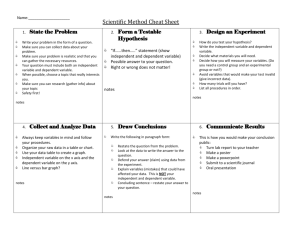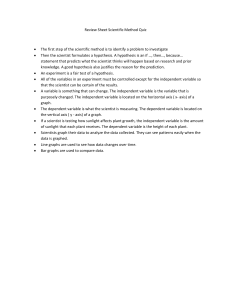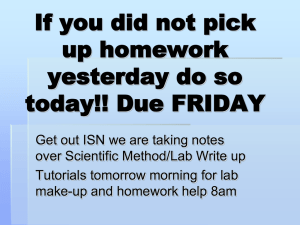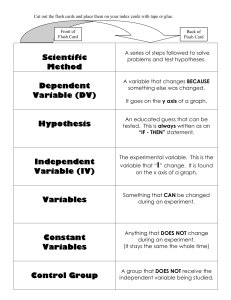Scientific Method Study Guide: Definitions & Steps
advertisement
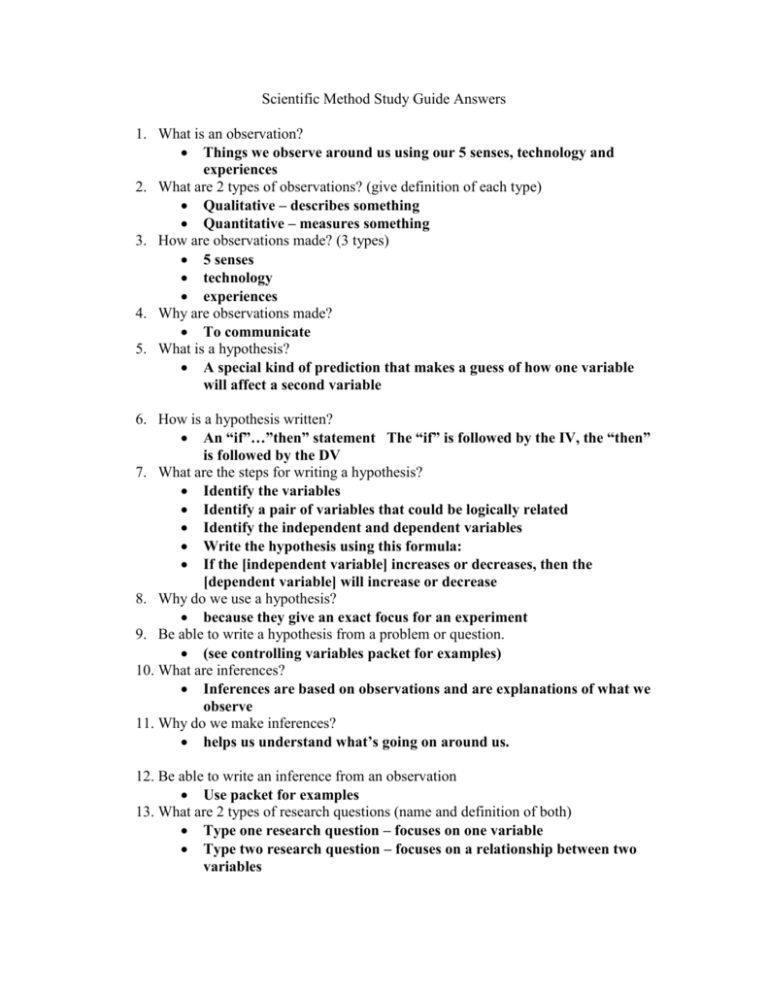
Scientific Method Study Guide Answers 1. What is an observation? Things we observe around us using our 5 senses, technology and experiences 2. What are 2 types of observations? (give definition of each type) Qualitative – describes something Quantitative – measures something 3. How are observations made? (3 types) 5 senses technology experiences 4. Why are observations made? To communicate 5. What is a hypothesis? A special kind of prediction that makes a guess of how one variable will affect a second variable 6. How is a hypothesis written? An “if”…”then” statement The “if” is followed by the IV, the “then” is followed by the DV 7. What are the steps for writing a hypothesis? Identify the variables Identify a pair of variables that could be logically related Identify the independent and dependent variables Write the hypothesis using this formula: If the [independent variable] increases or decreases, then the [dependent variable] will increase or decrease 8. Why do we use a hypothesis? because they give an exact focus for an experiment 9. Be able to write a hypothesis from a problem or question. (see controlling variables packet for examples) 10. What are inferences? Inferences are based on observations and are explanations of what we observe 11. Why do we make inferences? helps us understand what’s going on around us. 12. Be able to write an inference from an observation Use packet for examples 13. What are 2 types of research questions (name and definition of both) Type one research question – focuses on one variable Type two research question – focuses on a relationship between two variables 14. What are variables? Variables are factors, conditions and/or relationships that can change or be changed in an event or system. 15. List and give a definition for each type of variable (3 types) The independent variable is the variable you purposely change. The dependent variable is the variable that is being observed, which changes in response to the independent variable. The variables that are not changed are called controlled variables. 16. Be able to identify variables (look at packets for help) 17. Why do you need to organize data? Organizing Data helps you interpret what has been observed. 18. What is data interpretation? Data interpretation = making sense of observations 19. How is data organized? Data tables and charts 20. What visual image is used to display data? Graphs 21. How do you write a data table? IV data goes on the left side, DV data goes on the right side 22. What do graphs do? Graphs convert data sets into pictures 23. What are the rules for graphing? Always write a title at the top of the page for your graph Decide if you need a line or bar graph 24. How do you decide if you use a line or bar graph? Way to decide: If IV represents passage of time or measurement, you need a line graph If IV is types of things, you need a bar graph 25. Know which axis the IV and DV go on a graph Y axis goes up and down X axis is horizontal Y axis contains the Dependent variable data X axis contains the Independent variable data 26. Describe how to use increments on a graph Increments for x axis and y axis can be numbered differently, but the numbering progression must be consistent Look at the range for your data and set up the increments for each axis 27. Explain how to make a bar graph Number the increments on the Y axis only Write the categories for the IV on the X axis Decide how wide each bar should be The height of each bar should correspond with the number counted on the Y axis 28. Explain how to make a line graph Plot your data The matched pair (IV,DV) represents the coordinates for one point on the graph line. Connect the points on the line graph Steps of the Scientific Method and Lab Write Up: 1. Title – Reflects purpose of the lab 2. Statement of the problem – Purpose of the experiment 3. Hypothesis – An educated guess/prediction for the outcome of the experiment. Never us personal pronouns like “I” “he” “she” etc. 4. Procedure – All materials and steps for the experiment 5. Results – Data and results from experiment. Includes data tables and graphs 6. Conclusion – Hypothesis is re-stated and tells if it was correct or incorrect. Analyze the data in this step.
